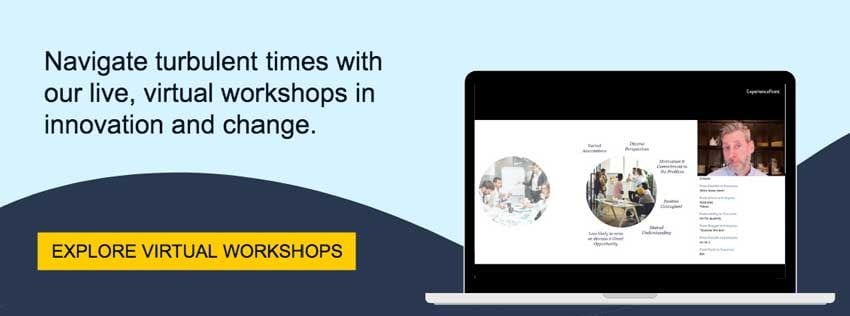As the world’s business leaders carry on into the latter half of one calendar year spent facing the never-before-faced, it may be a difficult ask for the most resilient of them to maintain and foster a sense of optimism. Surrounded by workforce communities that have been tested in every way imaginable, and whose capacity to imagine clearer skies ahead may be considerably compromised, encouraging a mindset of Relentless Optimism may seem an impossibility.
Yet it is worth reminding in this time more than ever that Relentless Optimism — one of the five mindsets of all great leaders as determined by ExperiencePoint’s extensive research in the field of innovation leadership — is the most crucial and impactful of the group. Where in tandem these five mindsets ignite the organizational conditions for innovation, Relentless Optimism is the catalyst that drives the encompassing process of innovative leadership forward.
Before the advent of the global pandemic, we described an optimistic leader as “possessing the confidence that ‘much better’ can exist and is worth pursuing despite challenges and uncertainty. In a mid-pandemic world where challenges and uncertainty reign supreme, this definition applies more explicitly than ever.=
It is the time for leaders to not only ask how “might I instill confidence in my people when they’re working through the uncertainty of innovation”, but also, “how might I instill confidence in my people when they’re working in a time of great uncertainty.” Asking these questions takes empathy, and an understanding from leaders that their people may be more tentative than ever before to dream big and think wildly. This is the very reason why it is time for leaders to put the mindset of Relentless Optimism into vigorous practice, to encourage perseverance in times of struggle.
In times of great challenge the Optimistic Leader will strive to:
Highlight the Wins
It is possible that in this time of great difficulty the wins, even to leaders, might seem imperceptible. Facing substantial losses and seismic shifts the rhythms of their operations, it may be difficult to engage in a sincere pattern of highlight great wins. It is for that reason that leaders must endeavour to acknowledge the small wins between the large ones, in order to motivate a workforce.
Perhaps this newfound effort will mean opening up a virtual shout-out board in which leaders and employees regularly acknowledge the efforts, ideas and small victories of colleagues. At ExperiencePoint we do just this by way of platform 15Five, which encourages tagged acknowledgements of the work of anyone in the company week-to-week.
Further, the Optimistic Leader would benefit from reminding their workforce of wins of the past and times that challenges have been overcome. Reminding the company’s individuals that they are a part of a resilient, strong and compassionate community will help them to begin looking boldly towards the future.
Destigmatize Failure
It may sound counterintuitive for leaders to encourage failure during challenging times, but a working community cannot begin to embrace optimism and possibility if they are taught to fear failure. A sense of trepidation in the face of failure simply works to stagnate the innovation process, wiping out any change for optimism to thrive.
We can look to the example of a Silicon Valley leader who realized that more had to be done to motivate her people to search for better solutions. As such, she decided to launch a regular ‘failure meeting’ in which her direct reports were expected to show up and share the biggest failure they had recently, what they had learned as a result, and how they’re using the learning to change what they do now.
In this way, risk was rewarded and encouraged rather than punished. The Optimistic Leader will also not be afraid to admit to failure or the challenges they are facing in these tricky times — this candour and humility will work to create a sense of community in which everyone, whether in bleak times or otherwise, will be able to look to the future with hope.
Show Empathy in Optimism
When speaking about relentlessly optimistic leaders, it would be silly not to acknowledge the working style of innovative powerhouse Steve Jobs. It has been told by many of his former employees that when anyone came to Jobs with a seemingly impossible challenge and declared “I can’t”, the leader would consistently respond with total conviction, “you can”, and fully expect that the individual would come through on the task.
In the context of today, where significant barriers have forced many businesses to confront what seem like impossible roadblocks, it may be helpful for leaders to take a page from Jobs’s method, but to do so with empathy for the unique situations of your working community. As such, instead of taking a hard lined “you can” in all scenarios, it might be additionally impactful to express “you can, and we will help you to do so.”
Where collaboration and community is an uncompromisable necessity of successful human-centered design, so is it necessary when encouraging optimism in delicate and uncertain times. Making it abundantly clear that individuals in a workforce who are supported by one another, and by their leader or leaders, will go far in fostering and rekindling the light of optimism through dark times.
